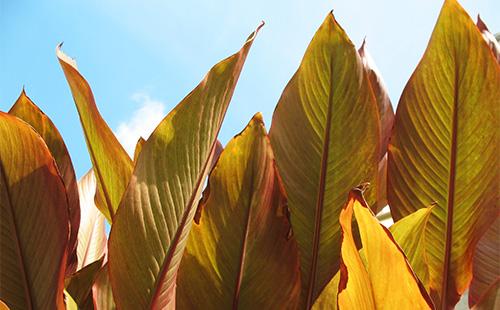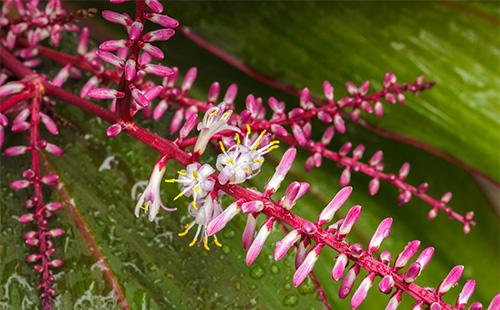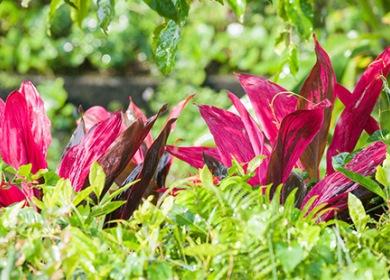The content of the article
Unusual, but sonorous name cordilina received, thanks to a kind of root system. The word is of Greek origin and is formed from the root kordyle, which in translation into Russian means a knot. However, fleshy roots secrete not only apricot dracaena, but also most plants of the asparagus family.
Do not confuse cordiline with ordinary dracaena. These are different plants. The first, unlike the second, gives root offspring. A section of its root has a white color. While the cut of the root of the dracaena is painted in a light orange color.
Views of the southerner
There are about 15 species of cordilina. Some of them settled in New Zealand and Australia. The homeland for others is the Asian subtropics. Cordilina got even to Brazil. True, only one species managed to overcome the Atlantic. The features of different types can be found in more detail in the table.
Table - types of cordilina and their features
| View | Type of | Height, m | Features |
|---|---|---|---|
| Cordilina Banks | - shrub | 1,5-3 | - Lanceolate leaves; - stretched up and directed to the top. |
| Cordilina Verkhushechnaya | - shrub | 2-3 | - Shrub with a thin single trunk; - sometimes the trunk is split into several parts |
| Cordilina Red | - shrub | up to 4 | - Leaves in length reach 0.5 m; - loves cool |
| Cordilina undivided | - Tall tree | up to 12 | - The front of the sheet has a dull green color; - internal - gray-haired; - loves cool |
| Cordilina straight | - Tree | until 3 | - Leathery sheet plate; - notches around the perimeter of the sheet |
| Cordilina South | - Tree | up to 12 | - Blooms with fragrant white inflorescences |
Growing cordilina at home directly depends on what type of tropical beauty you are dealing with. The apical easily fit on the windowsill and require heat. And red, for example, will have to be placed in the winter garden, because in a warm house the bush will not feel comfortable.
Cordilina care: what to consider
Caring for cordilina in a pot is somewhat different for different species. However, the set of basic rules of a caring grower remains unchanged.
Lighting
The tropical bush does not have much love for the direct rays of the sun. He would admire what is happening outside the window, sitting on the eastern or western windowsill.Bright, but diffused lighting for him just right.
Air temperature
To answer the question of how to care for cordilina after purchase, and what temperature regime will be optimal for it, you need to know exactly the type and variety of the flora. In summer, both tropical and subtropical shrubs feel comfortable in the temperature range from 20 to 25 ° C. But in winter, the former will be quite comfortable with the regime in the region of 18-20 ° C, and the latter will have to be removed from the apartment and sent to spend the winter on an insulated loggia or in the winter garden. The optimum temperature for subtropical cordilins in the cold season is considered to be from 5 to 10 ° C.
Watering
In the summer season, you need to water cordilina, like many other indoor plants, after drying of the upper soil layer. In winter, subtropical princesses living at low temperatures, water extremely carefully and carefully, trying not to overmoisten the soil.
Spraying
Subtropical plants do not need high humidity, so you can not bother running around the bush with a spray gun in your hands. And tropical beauties need to be sprayed once in one to two days during the vegetative period. In the cold season, spraying should be carried out less often - once a week.
Top dressing
Feeding a proud beauty should begin in the spring, continuing to fertilize the plant until the end of autumn. Reviews of experienced gardeners indicate that the weekly feeding of a home shrub is considered optimal. For this purpose, it is worth purchasing a universal fertilizer, which is sold in any flower shop. In the cold season, the number of top dressings from four per month is reduced to one.
Transfer
If the domestic plant is still young, then it will have to be transplanted annually. Cordilins from the age of four years require a transplant less often - once every three years.
To transplant a proud representative of the jungle, you need not only to buy a pot wider and deeper than the previous one, but also to properly prepare the soil.
Preparing a Mix
- We take three parts of slightly acidic earth from the garden.
- Add one piece of sand.
- Add one part of peat.
- Mix the soil thoroughly.
- Pour drainage into the pot.
- On top, pour the earth prepared for transplanting the plant.
Pruning
Not sure how to prune cordilina properly and are afraid to damage the plant? Do not worry, but boldly pick up a sharp kitchen knife. With a slight movement of the hand, cut off the top and be sure: with this action you will not only rejuvenate the plant, but also get excellent planting material for further propagation of the room palm.
Reproduction: 3 ways
At home, you can “clone” a home palm tree in three ways: by grafting, by seeds, and by rhizome division. Any of them is not too complicated to implement, which means that even a beginner grower can do it.
Cuttings
Features. In order to propagate cordilina with apical cuttings, you will need to take planting material from the top or from the middle. Too long cuttings can be divided into several parts, leaving three to four leaves, and begin to plant each of them.
Action algorithm
- We fill the tank with earth mixture according to the recipe indicated above.
- We root by making sure that the temperature in the room is quite high (ideally around 28 ° C).
- Within a month, we spray the cuttings from the spray gun and carefully water the soil.
- After a month, we plant rooted cuttings in a permanent pot.

Seeds
Features. The method is the most "ungrateful." Seedlings have to wait too long, and not all seeds germinate. Seed is planted in early March. The first sprouts can be expected after a few weeks, and the weakest will hatch not earlier than after two months.
Action algorithm
- We prepare the soil according to the above recipe.
- Sow the seeds at a distance of 1-2 cm from each other.
Rhizome division
Description. The division of rhizomes is carried out in early or mid-spring. Planting separated fragments is similar to planting cuttings.
Action algorithm
- We divide the rhizome, after removing the roots from it.
- We plant each fragment in a prepared soil mixture.
- Within a month and a half, we wait for the formation of roots.
- We transplant each into a permanent pot.
Diseases and enemies among insects
Cordilin, like ficus with dracaena, is very susceptible to the destructive influence of all kinds of insect pests. In addition, she is able to suffer from improper actions of the grower and insufficient attention on his part.
The main problems and their causes
As a rule, diseases of a home palm are a consequence of illiterate care. Understanding what caused the foliage to change, you can quickly navigate and correct the mistakes made. It is in the correction of the rules of care that treatment lies.
Table - Cordilina diseases and their causes
| Disease | Cause |
|---|---|
| Cordilina dry leaf tips | - Direct rays of the sun |
| Brown-brown spots of different diameters appear on the foliage | - The plant does not have enough moisture (watering); - too dry indoor air |
| Leaves turn yellow and curl. | - Cordilina is too cold |
| Root rot | - excess moisture |
When decaying the root system, there is only one way out - cut off the upper part of the proud home palm and root it in a separate pot. It is unclear whether the mother plant will survive, but by rooting the top, you can probably save the flower.

Pests
The fierce enemies of the Cordilina are mealybugs that leave characteristic traces on the stems, spider mites jumping onto a flower from bouquets brought from the street, scale shield and aphids. If the pest is insignificant, the plant can be cured by mechanical cleaning. If the enemy does not retreat, they will have to fight with the help of chemical agents.
Table - Pests of cordilina, symptoms of damage and methods of treatment
| Pest | Symptoms of lesion | Method of treatment |
|---|---|---|
| Spider mite | - The appearance of cobwebs on leaf plates; - the appearance of miniature black dots (punctures made by a tick) | - We put a plastic bag on the pot, tying it at the base of the trunk or stem; - bathe cordiline in the shower, thoroughly washing off the pest; - sponge each sheet individually |
| Whitefly | - On the reverse side of the plate are tiny white flakes (larvae); - white plaque on the stems; - dark spots on the leaves | - Lower the air temperature in the room; - wipe the leaves with a damp sponge, removing the larvae along with adult insects; - once a week, repeat the action |
| Mealybug | - On the leaves are white clusters in the form of small lumps similar to cotton wool; - a white coating appeared on the rhizome; - the leaves began to turn yellow and fall | - Grind several cloves of garlic; - pour 0.5 liters of boiling water; - insist and let the mixture cool; - wipe the leaves with a solution using a sponge, cleaning from pests |
| Shield | - Small brown insects appear on the stem; - insects are deployed on the back of the leaf plate | - Wet a piece of cotton with a small amount of methyl alcohol; - wipe with a swab each leaf of the plant |
| Aphid | - Twisting of foliage; - discoloration of the leaves; - falling | - We process with a sponge dipped in water to eliminate insects from the surface of the plant; - organize a warm shower |
If after applying folk methods pests could not be removed, it is necessary to use heavy artillery - insecticides. Chemical products must be diluted strictly according to the instructions contained on the package.
And finally, a few more tips on how to care for cordilina. Tropical beauty loves when her owner loosens the topsoil. Manual aeration contributes to the healing of the plant and its intensive growth. If you suddenly find a white salt crust on the surface of the soil, carefully remove this earth and add fresh soil. Cordilin with long narrow leaves should be watered somewhat less frequently than varieties with a wide leaf plate. The second evaporates moisture much more than the first, due to the larger leaf area.
Reviews: "Capricious, but beautiful!"
I bought this plant about a year ago. Bribed an unusual look of leaves, with a colored raspberry border. The plant was small and frail, only a few leaves. I did a plant transplant right away, as I brought it home. I really did not like his tortured appearance. Transplanted, watered and literally a few hours later the plant came to life, rose, recovered somehow. In general, we got along with him and made friends.
Anapanka, http://otzovik.com/review_453812.html
I really liked this flower and here my husband gave me this cordilina on March 8th. I’ll say right away that it’s hard to find it - this is a rather rare houseplant, so when my husband brought it to me, I was incredibly happy. But at that moment I had in my hands a very tiny daughter, which required constant care and care, so the flower lost proper care. But he did not remain in debt - he immediately repaid me with a spoiled decorative look. The fact is that if you do not spray cordilina (she loves it very much), then its leaves begin to turn yellow, become covered with bright dots and the appearance of course becomes unpleasant. In addition, it is susceptible to infection with thrips and other pests if there is insufficient watering or spraying. So my cordilinka began to die slowly. But this summer I took it seriously. Sprayed 2 times with her fitotherm. Then she began to spray the leaves every other day and she perked up, even brought me “offspring” - 3 small cordilins. Now I enjoy her beauty and try to look after her.
Ray of light, http://irecommend.ru/content/kordilina-pryamaya

